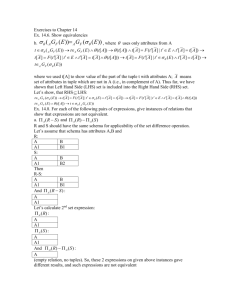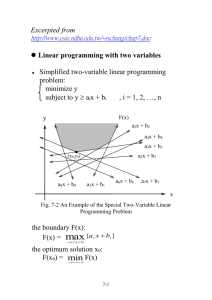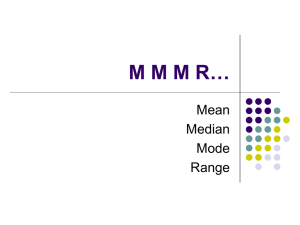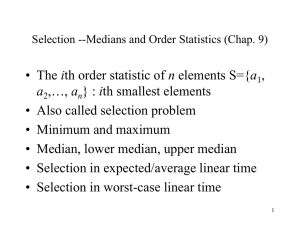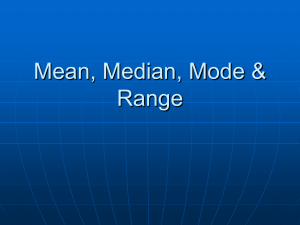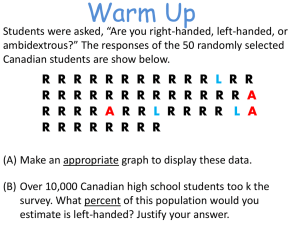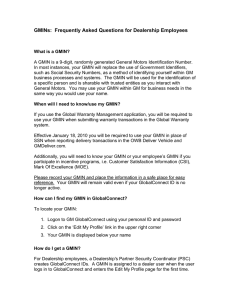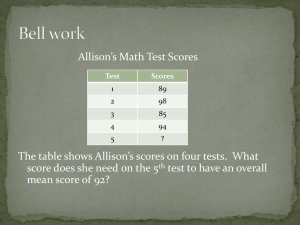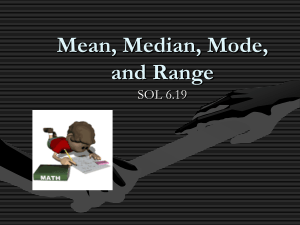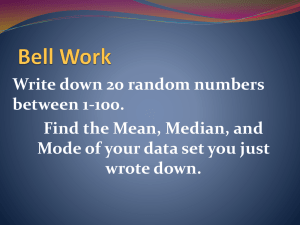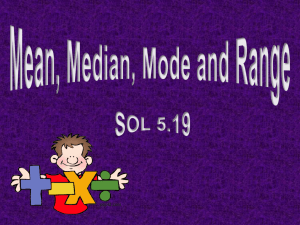Chap 6 Prune-and
advertisement
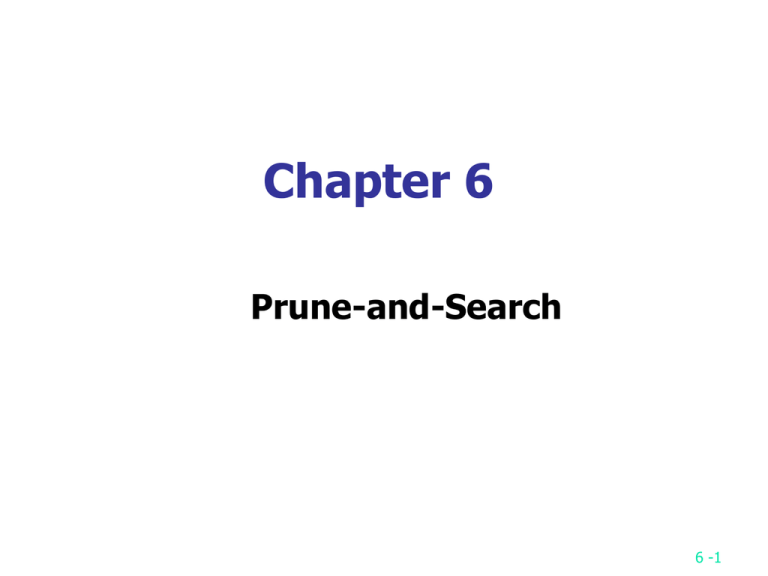
Chapter 6
Prune-and-Search
6 -1
A simple example: Binary
search
sorted sequence : (search 9)
1
4
5
7
9
10 12 15
step 1
step 2
step 3
After each comparison, a half of the data set are
pruned away.
Binary search can be viewed as a special divideand-conquer method, since there exists no
solution in another half and then no merging is
done.
6 -2
The selection problem
Input: A set S of n elements
Output: The kth smallest element of S
The median problem: to find the
smallest element.
The straightforward algorithm:
n
2
-th
step 1: Sort the n elements
step 2: Locate the kth element in the sorted list.
Time complexity: O(nlogn)
6 -3
Prune-and-search concept for
the selection problem
S={a1, a2, …, an}
Let p S, use p to partition S into 3 subsets S1 , S2 ,
S3:
S ={ a | a < p , 1 i n}
1
i
i
S ={ a | a = p , 1 i n}
2
i
i
S ={ a | a > p , 1 i n}
3
i
i
3 cases:
If |S1| k , then the kth smallest element of S is
in S1, prune away S2 and S3.
Else, if |S | + |S | k, then p is the kth smallest
1
2
element of S.
Else, the kth smallest element of S is the (k - |S |
1
- |S2|)-th smallest element in S3, prune away S1
and S2.
6 -4
How to select P?
The n elements are divided into
(Each subset has 5 elements.)
n
5
subsets.
At least 1/4 of S known to be less than or equal to P.
Each 5-element subset is
sorted in non-decreasing
sequence.
P
M
At least 1/4 of S known to be
greater than or equal to P.
6 -5
Prune-and-search approach
Input: A set S of n elements.
Output: The kth smallest element of S.
Step 1: Divide S into n/5 subsets. Each subset
contains five elements. Add some dummy
elements to the last subset if n is not a net
multiple of S.
Step 2: Sort each subset of elements.
Step 3: Recursively, find the element p which is
the median of the medians of the n/5
subsets..
6 -6
Step 4: Partition S into S1, S2 and S3, which
contain the elements less than, equal to, and
greater than p, respectively.
Step 5: If |S1| k, then discard S2 and S3 and
solve the problem that selects the kth
smallest element from S1 during the next
iteration;
else if |S1| + |S2| k then p is the kth smallest
element of S;
otherwise, let k = k - |S1| - |S2|, solve the
problem that selects the k’th smallest element
from S3 during the next iteration.
6 -7
Time complexity
At least n/4 elements are pruned away during
each iteration.
The problem remaining in step 5 contains at
most 3n/4 elements.
Time complexity: T(n) = O(n)
step 1: O(n)
step 2: O(n)
step 3: T(n/5)
step 4: O(n)
step 5: T(3n/4)
T(n) = T(3n/4) + T(n/5) + O(n)
6 -8
Let T(n) = a0 + a1n + a2n2 + … , a1 0
T(3n/4) = a0 + (3/4)a1n + (9/16)a2n2 + …
T(n/5) = a0 + (1/5)a1n + (1/25)a2n2 + …
T(3n/4 + n/5) = T(19n/20) = a0 + (19/20)a1n +
(361/400)a2n2 + …
T(3n/4) + T(n/5) a0 + T(19n/20)
T(n) cn + T(19n/20)
cn + (19/20)cn +T((19/20)2n)
cn + (19/20)cn + (19/20)2cn + … +(19/20)pcn +
T((19/20)p+1n) , (19/20)p+1n 1 (19/20)pn
19
= 1 ( 20) cn b
p 1
1
19
20
20 cn +b
= O(n)
6 -9
The general prune-and-search
It consists of many iterations.
At each iteration, it prunes away a fraction,
say f, 0<f<1, of the input data, and then it
invokes the same algorithm recursively to
solve the problem for the remaining data.
After p iterations, the size of input data will
be q which is so small that the problem can
be solved directly in some constant time c.
6 -10
Time complexity analysis
Assume that the time needed to execute the
prune-and-search in each iteration is O(nk)
for some constant k and the worst case run
time of the prune-and-search algorithm is
T(n). Then
T(n) = T((1f ) n) + O(nk)
6 -11
We have
T(n) T((1 f ) n) + cnk for sufficiently large n.
T((1 f )2n) + cnk + c(1 f )knk
c’+ cnk + c(1 f )knk + c(1 f )2knk + ... + c(1 f )pknk
= c’+ cnk(1 + (1 f )k + (1 f )2k + ... + (1 f ) pk).
Since 1 f < 1, as n ,
T(n) = O(nk)
Thus, the time-complexity of the whole pruneand-search process is of the same order as the
time-complexity in each iteration.
6 -12
Linear programming with two
variables
Minimize ax + by
subject to aix + biy ci , i = 1, 2, …, n
Simplified two-variable linear programming
problem:
Minimize y
subject to y aix + bi, i = 1, 2, …, n
6 -13
F(x)
y
a2x + b2
a4x + b4
a3x + b3
(x0,y0)
a8x + b8
a5x + b5
a1x + b1
a6x + b6
a7x + b7
x
The boundary F(x):
{ai x bi }
F(x) = max
1i n
The optimum solution x0:
F(x0) = min
F(x)
x
6 -14
Constraints deletion
y
a1x + b1
a2x + b2
a4x + b4
a3x + b3
a5x + b5
May be deleted
a6x + b6
a8x + b8
x0
a7x + b7
x
xm
If x0 < xm and the
intersection of a3x +
b3 and a2x + b2 is
greater than xm, then
one of these two
constraints is always
smaller
than
the
other for x < xm.
Thus, this constraint
can be deleted.
It is similar for x0 >
xm .
6 -15
Determining the direction of the
optimum solution
Suppose an xm is known.
How do we know whether
x0 < xm or x0 > xm ?
y
y'm
x0
Let ym = F(xm) = max {a x
Case 1: ym is on
only one constraint.
x0
ym
x'm
xm
i m
1i n
Let g denote the
slope of this
constraint.
If g > 0, then x0 <
xm.
If g < 0, then x0 >
xm.
The cases where xm is on only
x one constrain.
6 -16
bi }
y
Case 2: ym is the
intersection of several
constraints.
{a | a x b F ( x )}
g
max= max
1i n
gmax
gmin
gmax
gmin
xm,1
xm,2
gmax
gmin
Case 2a: xm,3
Case 2b: xm,1
Case 2c: xm,2
xm,3
Cases of xm on the intersection of several
constraints.
i
i m
i
m
max. slope
{ai | ai xm bi F ( xm )}
gmin = min
1i n
min. slop
If g
min > 0, gmax > 0,
then x0 < xm
If g
min < 0, gmax < 0,
then x0 > xm
If g
min < 0, gmax > 0 ,
x
then (xm, ym) is the
optimum solution.
6 -17
How to choose xm?
We arbitrarily group the n constraints
into n/2 pairs. For each pair, find their
intersection. Among these n/2
intersections, choose the median of
their x-coordinates as xm.
6 -18
Prune-and-Search approach
Input: Constraints S: aix + bi, i=1, 2, …, n.
Output: The value x0 such that y is minimized at
x0 subject to the above constraints.
Step 1: If S contains no more than two constraints,
solve this problem by a brute force method.
Step 2: Divide S into n/2 pairs of constraints
randomly. For each pair of constraints aix + bi
and ajx + bj, find the intersection pij of them and
denote its x-value as xij.
Step 3: Among the xij’s, find the median xm.
6 -19
{ai xm bi }
Step 4: Determine ym = F(xm) = max
1i n
gmin = min {a | a x b F ( x )}
gmax = max {a | a x b F ( x )}
Step 5:
Case 5a: If gmin and gmax are not of the same
sign, ym is the solution and exit.
Case 5b: otherwise, x0 < xm, if gmin > 0, and x0
>xm, if gmin < 0.
i
1i n
1i n
i
i m
i m
i
i
m
m
6 -20
Step 6:
Case 6a: If x0 < xm, for each pair of constraints
whose x-coordinate intersection is larger than xm,
prune away the constraint which is always
smaller than the other for x xm.
Case 6b: If x0 > xm, do similarly.
Let S denote the set of remaining constraints. Go
to Step 2.
There are totally n/2 intersections. Thus, n/4
constraints are pruned away for each iteration.
Time complexity:
T(n) = T(3n/4)+O(n)
= O(n)
6 -21
The general two-variable
linear programming problem
Minimize ax + by
subject to aix + biy ci , i = 1, 2, …, n
Let x’ = x
y’ = ax + by
Minimize y’
subject to ai’x’ + bi’y’ ci’ , i = 1, 2, …, n
where ai’ = ai –bia/b, bi’ = bi/b, ci’ = ci
6 -22
Change the symbols and rewrite as:
y
Minimize y
subject to y aix + bi ( i I1 )
y aix + bi ( i I2 )
axb
Define:
F1(x) = max {aix + bi , i I1}
F2(x) = min {aix + bi , i I2}
Minimize F1(x)
F2(x)
F1(x)
a
x
b
subject to F1(x) F2(x), a x b
Let F(x) = F1(x) - F2(x)
6 -23
If we know x0 < xm, then a1x + b1 can be deleted
because a1x + b1 < a2x + b2 for x< xm.
Define:
gmin = min {ai | i I1, aixm + bi = F1(xm)}, min. slope
gmax = max{ai | i I1, aixm + bi = F1(xm)}, max. slope
hmin = min {ai | i I2, aixm + bi = F2(xm)}, min. slope
hmax = max{ai | i I2, aixm + bi = F2(xm)}, max. slope
6 -24
Determining the solution
y
Case 1: If F(xm) 0, then xm is feasible.
Case 1.b: If gmin < 0,
gmax < 0, then x0 > xm.
Case 1.a: If gmin > 0,
gmax > 0, then x0 < xm.
y
F2(x)
F2(x)
F1(x)
gmax
F1(x)
gmin
x0 xm
x
gmin
gmax
xm
x0
6 -25
x
Case 1.c: If gmin < 0, gmax > 0, then xm is the
optimum solution.
y
F2(x)
F1(x)
gmin
gmax
x
x m = x0
6 -26
Case 2: If F(xm) > 0, xm is infeasible.
Case 2.a: If gmin > hmax,
then x0 < xm.
Case 2.b: If gmin < hmax,
then x0 > xm.
y
y
F1(x)
F1(x)
gmin
gmax
hmax
hmin
F2(x)
F2(x)
x0 xm
x
x
xm
x0
6 -27
Case 2.c: If gmin hmax, and gmax hmin, then
no feasible solution exists.
y
F1(x)
gmax
gmin
hmax
hmin
F2(x)
x
xm
6 -28
Prune-and-search approach
Input: Constraints:
I1: y aix + bi, i = 1, 2, …, n1
I2: y aix + bi, i = n1+1, n1+2, …, n.
axb
Output: The value x0 such that
y is minimized at x0
subject to the above constraints.
Step 1: Arrange the constraints in I1 and I2 into
arbitrary disjoint pairs respectively. For each
pair, if aix + bi is parallel to ajx + bj, delete
aix + bi if bi < bj for i, jI1 or bi > bj for i,
jI2. Otherwise, find the intersection pij of y
= aix + bi and y = ajx + bj. Let the xcoordinate of pij be xij.
6 -29
n
2
Step 2: Find the median xm of xij’s (at most
points).
Step 3:
a. If xm is optimal, report this and exit.
b. If no feasible solution exists, report this
and exit.
c. Otherwise, determine whether the
optimum solution lies to the left, or right,
of xm.
Step 4: Discard at least 1/4 of the constraints.
Go to Step 1.
Time complexity:
T(n) = T(3n/4)+O(n)
= O(n)
6 -30
The 1-center problem
Given n planar points, find a smallest
circle to cover these n points.
6 -31
The pruning rule
L1 2: bisector of segment connecting p1 and p2 ,
L3 4: bisector of segments connecting p3 and p4
P1 can be eliminated without affecting our solution.
The area where the
center of the optimum
circle is located.
p3
L34
p4
y
p1
L12
p2
x
6 -32
The constrained 1-center
problem
The center is restricted to lying on a
straight line.
Lij
Pi
Pj
y=0
x*
xm
xij
6 -33
Prune-and-search approach
Input : n points and a straight line y = y’.
Output: The constrained center on the
straight line y = y’.
Step 1: If n is no more than 2, solve this problem by a
brute-force method.
Step 2: Form disjoint pairs of points (p1, p2), (p3,
p4), …,(pn-1, pn). If there are odd number of points,
just let the final pair be (pn, p1).
Step 3: For each pair of points, (pi, pi+1), find the point
xi,i+1 on the line y = y’ such that d(pi, xi,i+1) = d(pi+1,
xi,i+1).
6 -34
Step 4: Find the median of the 2 xi,i+1’s. Denote it as
xm.
Step 5: Calculate the distance between pi and xm for all
i. Let pj be the point which is farthest from xm. Let xj
denote the projection of pj onto y = y’. If xj is to the
left (right) of xm, then the optimal solution, x*, must
be to the left (right) of xm.
Step 6: If x* < xm, for each xi,i+1 > xm, prune the point
pi if pi is closer to xm than pi+1, otherwise prune the
point pi+1;
If x* > xm, do similarly.
Step 7: Go to Step 1.
n
Time complexity
T(n) = T(3n/4)+O(n)
= O(n)
6 -35
The general 1-center problem
By the constrained 1-center algorithm, we can
determine the center (x*,0) on the line y=0.
We can do more
Let (xs, ys) be the center of the optimum circle.
We can determine whether ys > 0, ys < 0 or ys = 0.
Similarly, we can also determine whether xs > 0, xs < 0
or xs = 0
6 -36
The sign of optimal y
Let I be the set of points which are farthest
from (x*, 0).
Case 1: I contains one point P = (xp, yp).
ys has the same sign as that of yp.
6 -37
Case 2 : I contains more than one point.
Find the smallest arc spanning all points in I.
Let P1 = (x1, y1) and P2 = (x2, y2) be the two
end points of the smallest spanning arc.
If this arc 180o , then ys = 0.
y y
else ys has the same sign as that of 1 2 2 .
P1
P1
P3
P4
P2
(x*, 0)
y=0
P3
(x*, 0)
y=0
P2
(a)
(b)
(See the figure on the next page.)
6 -38
Optimal or not optimal
an acute triangle:
The circle is optimal.
an obtuse triangle:
The circle is not optimal.
6 -39
An example of 1-center problem
y
ym
xm
x
One point for each of n/4 intersections of Li+ and Liis pruned away.
Thus, n/16 points are pruned away in each iteration.
6 -40
Prune-and-search approach
Input: A set S = {p1, p2, …, pn} of n points.
Output: The smallest enclosing circle for S.
Step 1: If S contains no more than 16 points,
solve the problem by a brute-force method.
Step 2: Form disjoint pairs of points, (p1, p2),
(p3, p4), …,(pn-1, pn). For each pair of points,
(pi, pi+1), find the perpendicular bisector of
line segment pi pi1 .Denote them as Li/2, for i =
2, 4, …, n, and compute their slopes. Let the
slope of Lk be denoted as sk, for k = 1, 2,
3, …, n/2.
6 -41
Step 3: Compute the median of sk’s, and denote
it by sm.
Step 4: Rotate the coordinate system so that
the x-axis coincide with y = smx. Let the set
of Lk’s with positive (negative) slopes be I+ (I). (Both of them are of size n/4.)
Step 5: Construct disjoint pairs of lines, (Li+, Li-)
for i = 1, 2, …, n/4, where Li+ I+ and Li-
I-. Find the intersection of each pair and
denote it by (ai, bi), for i = 1, 2, …, n/4.
6 -42
Step 6: Find the median of bi’s. Denote it as y*.
Apply the constrained 1-center subroutine to
S, requiring that the center of circle be
located on y=y*. Let the solution of this
constrained 1-center problem be (x’, y*).
Step 7: Determine whether (x’, y*) is the
optimal solution. If it is, exit; otherwise,
record ys > y* or ys < y*.
6 -43
Step 8: If ys > y*, find the median of ai’s for
those (ai, bi)’s where bi < y*. If ys < y*, find the
median of ai’s of those t hose (ai, bi)’s where bi >
y*. Denote the median as x*. Apply the
constrained 1-center algorithm to S, requiring
that the center of circle be located on x = x*. Let
the solution of this contained 1-center problem
be (x*, y’).
Step 9: Determine whether (x*, y’) is the
optimal solution. If it is, exit; otherwise,
record xs > x* and xs < x*.
6 -44
Step 10:
Case 1: x < x* and y < y*.
s
s
Find all (ai, bi)’s such that ai > x* and bi > y*. Let
(ai, bi) be the intersection of Li+ and Li-. Let Li- be
the bisector of pj and pk. Prune away pj(pk) if pj(pk)
is closer to (x*, y*) than pk(pj).
Case 2: x > x* and y > y*. Do similarly.
s
s
Case 3: x < x* and y > y*. Do similarly.
s
s
Case 4: x > x* and y < y*. Do similarly.
s
s
Step 11: Let S be the set of the remaining points. Go to
Step 1.
Time complexity :
T(n) = T(15n/16)+O(n)
= O(n)
6 -45
